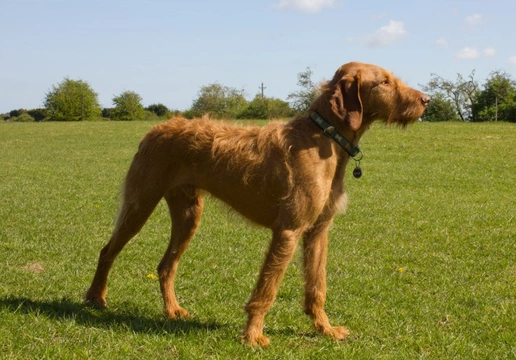
Introducing the wirehaired Hungarian Vizsla
The Hungarian Vizsla is one breed of dog that is really on the up within the UK, and these handsome red-coated pointer-type dogs are now becoming hugely popular all over the world. While up until as recently as ten or so years ago the Vizsla was a fairly unusual sight in the UK, today, most dog owners know at least one that they see out and about regularly when walking, or perhaps you have fallen for their charms and own a Hungarian Vizsla yourself!
However, while the Hungarian Vizsla itself is now widely owned and very popular, there is also a second Vizsla dog breed called the wirehaired Hungarian Vizsla, which is a close relative of the standard smooth coated variant, but that is actually recognised as a breed in its own right.
If you are interested in the wirehaired Hungarian Vizsla and want to find out more about their similarities and differences from the regular Vizsla, or if you didn’t even realise that there was a wirehaired variant and would like to know a little bit about them, this article is for you. Read on, and we will introduce the wirehaired Hungarian Vizsla in more detail, including looking at their commonalities and divergences from the more common standard Vizsla.
The wirehaired Hungarian Vizsla
The wirehaired Hungarian Vizsla (WHV) is actually a reasonably rare breed, and even in their home country of Hungary, only around thirty new litters of the breed are registered each year. However, as the popularity of the standard Vizsla is now quickly growing across the world, the same pattern is likely to follow in the WHV too, leading to increased demand for the breed and so, increasing numbers.
The wirehaired Hungarian Vizsla is classed as a sporting or pointing breed depending on the umbrella organisation’s registration standards, and they are recognised by all of the major international Kennel Clubs and registries such as the UK Kennel Club and the FCI.
Like the standard variant, the WHV was originally prized as a hunting dog, and they are natural pointers, as well as being highly trainable and keen to please, giving them a level of versatility shared by many pointer breeds, as well as the usual pointer good looks!
They are classed as above average for their working ability and are classed as easy to train and manage, and they also have excellent scenting abilities, and are adept at following a trail. They are also lively, fun loving and highly energetic, tempered by a marked gentleness and loving nature that makes them very appealing to owners from all walks of life. They have a natural flair for retrieving too, and they are generally good all-rounders that are equally suited to working roles, or life as pets.
While they are gentle, kind and love company, they can also be very protective of their families, and will actively guard their homes and particularly, family children if they perceive a threat! They love to swim, run and spend lots of time outdoors, but within the home they are quiet, calm and excellent housemates!
Their connection to the standard Vizsla
Comparisons between the wirehaired Hungarian Vizsla and the shorthaired variant are naturally very common, and the two breeds are of course closely related. The WHV breed is in fact an offshoot of the standard breed, and they were first developed during the 1930’s in an attempt to produce a dog that would retain all of the desirable traits of the smooth haired Vizsla, but with a heavier coat and build to make them more robust for a wide range of different working roles.
The very first dogs of the breed were produced from the crossing of Hungarian Vizslas with German wirehaired pointers, with the very first dogs used in the crossings chosen for their excellent working abilities and lovely natures.
The first dogs produced from the crossing had coats that fell between the German wirehaired pointer and the smooth Vizsla, and subsequent crossing ensured that a thicker, more wirehaired coat was subsequently bred into the line.
The end result when the breed gained formal recognition is a dog with a very similar size, build and conformation to the smooth haired Vizsla, but slightly larger and more muscular, although this deviation is so small as to be rather hard to spot! Also of course the wirehaired Hungarian Vizsla has a wiry coat, with a notable beard of fur on their chins.
Is the wirehaired Hungarian Vizsla a good choice of pet?
One of the things that has made the standard Hungarian Vizsla so popular worldwide is their great temperament and versatility, traits that are shared by the WHV. For active families that like to spend lots of time out of doors and doing things that the dog can join in with, they make excellent choices, and they are also worthy of consideration if you are keen to get a dog that may have a flair for canine sport.
However, as the breed is still relatively small in numbers, even in their home country of Hungary, you may have to go to quite some lengths in order to find one offered for sale-in which case, the regular Hungarian Vizsla might make for an excellent substitute.



